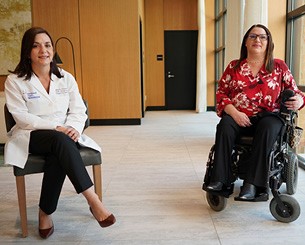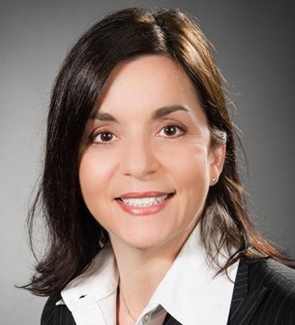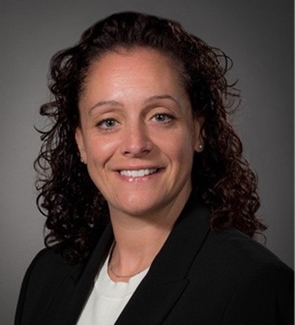Radiologists agree on the importance of breast cancer screening and are taking steps to improve access and empower women to make informed decisions. Click here to see steps you can take in your community and practice.
Lisa Panzica, MHA, has lived with the neurodegenerative disorder spinal muscular atrophy since she was a child. Unable to walk and reliant on a wheelchair, Panzica has come to expect daily obstacles and persists with positivity to overcome them. But when she was denied a screening mammogram due to her disability, Panzica was stunned. Still, she managed to turn her disappointment into action — partnering with the radiology team to improve care for patients living with physical limitations.
In 2019, Panzica, ambulatory health information manager at Northwell Health in New York, went to the system’s largest breast imaging center for her first screening mammogram. When she arrived for the appointment, Panzica was bewildered when the technologist instructed her to transfer from her wheelchair to an armless high-back chair for her mammogram. When Panzica was unable to complete the maneuver, the technologist told her that she couldn’t perform the mammogram and sent Panzica home without receiving the potentially life-saving screening exam.

Nina S. Vincoff, MD, and Lisa Panzica, MHA, partnered to improve the patient imaging experience at Northwell Health. Photo courtesy: Vaccine Labs |
At the time, Panzica happened to be spearheading an initiative at Northwell to improve access to care for patients with disabilities. Frustrated with her imaging experience (or lack thereof), Panzica contacted Nina S. Vincoff, MD, chief of breast imaging and radiology vice chair for patient experience, to inform her of the failed mammogram attempt and explain her patient inclusion initiative.
“Imaging can be extremely challenging for people with physical limitations, from maneuvering on and off the table to getting into position for an exam,” explains Panzica. “Many women who are physically disabled forgo mammograms and other potentially life-saving screening exams because of accessibility issues or just believing that they’ll be treated differently from other patients. I wanted to let the radiology team know about the challenges I faced in the department so that they could address them and help patients like me.”
Understanding the Situation
Panzica reached out to Vincoff directly to explain what happened during the appointment. During the conversation, Panzica shared both her positive and negative impressions of her mammogram visit. For example, Panzica said that while the check-in process was seamless, it became moot when the technologist was unable to adapt the transfer and positioning measures to accommodate her physical limitations. “Not only could I not get myself into the chair that was provided, I wouldn’t have been able to hold myself up without armrests,” Panzica explains.
As Panzica recounted her experience, Vincoff immediately recognized the urgency of the issue and acknowledged that the technologist should have brainstormed a solution rather than denying Panzica care. “The problem wasn’t about the specific disability. The problem was that the technologist wasn’t thinking outside of the box,” Vincoff says. “While you can’t prepare your staff for every possible situation, you can prepare them to have an open mind and patient-centered attitude to find the optimal solution.”
Panzica notes that her ability to reach out to Vincoff was enabled by her employment at Northwell and that most patients don’t experience the benefits of direct access. “Many patients face more of a battle, and often opt not to share feedback and pursue care simply because it is too much of a burden or they believe they just cannot because of their disability,” Panzica says. “As healthcare providers, patients place their full trust in us to ensure they receive the highest quality care. This is our responsibility, so I take the experiences that I’ve faced as opportunities to exceed our patients’ expectations every day.”
During their discussion, Vincoff assured Panzica that she could get her mammogram and rescheduled her appointment. Vincoff also invited Panzica to join the patient-family advisory council that she was forming in the imaging department and asked if she would be willing to tour the imaging center with Aimee Botsch, RT(R)(M), who leads the mammography team at Northwell, to help identify specific challenges that patients with disabilities face in the department. “Right away, when I voiced the reality of access and inclusion challenges for disabled patients, Dr. Vincoff was extremely interested in learning more,” Panzica recalls. “I knew it would be a productive partnership.”
Vincoff and Botsch were thrilled when Panzica accepted both opportunities. They knew that her insights would allow them to work with the technologists to reinforce the importance of both listening to patients’ needs and seeking the help of other technologists for atypical cases. “From our first conversation, I knew Lisa could be a great resource to teach us about what it’s like to be a person with disabilities in our office,” Vincoff explains. “I wanted to learn more about what it feels like for patients with physical limitations to be there — in our waiting area, in our changing area, in our exam rooms — and how we could make the environment more patient centric and patient friendly.”
Touring the Imaging Center
During the imaging center tour, Panzica, Vincoff, and Botsch walked through an entire patient visit from entry to departure. At each step in the process, Panzica offered ideas for improving the experience for patients who experience physical limitations. For instance, she suggested creating a waiting room that is more accessible for wheelchairs and minimizing wait times for patients who have disabilities and often rely on hired drivers for transportation.

Nina S. Vincoff, MD, chief of breast imaging and radiology vice chair for patient experience, seeks regular feedback from Northwell patients about their visits. |
Panzica also recommended providing digital forms on devices that include a stylus for patients who struggle to use touchscreens. And she suggested giving patients the opportunity to share challenges or concerns ahead of their appointments so that staff can be adequately prepared when they arrive. These could include anything from physical limitations and language barriers to mental disabilities and anxiety about the exam.
Panzica’s fresh lens provided valuable insight about what it’s like to be a patient — and more specifically, a patient with disabilities — in radiology, Botsch says. “Lisa’s feedback about the patient experience was enlightening because it wasn’t just the exam that was difficult. It was other things, right down to where we placed the hand sanitizer,” Botsch says. “It helped us understand the patient experience in a way that we wouldn’t have been able to if we hadn’t taken the time to walk through the facility with her.”
Implementing Changes
With Panzica’s input, Vincoff and her team began initiating numerous patient-centric changes to improve the imaging environment for patients who use wheelchairs. For instance, the team rearranged the waiting room to improve access, and the imaging center greeter moved from a standing to a seated position to be at eye level with patients who use wheelchairs. What’s more, Vincoff and Botsch are working with Northwell’s linen service to offer shorter, poncho-style capes that make it easier for patients to change while seated.
Based on Panzica’s feedback about gauging patients’ challenges and concerns ahead of time, the radiology team added a question to their digital intake form that asks patients about their limitations and needs. This allows the team to proactively respond to patients’ concerns and provide enough support for every patient to have the same access to care. “It’s important to listen to every patient because it’s their individual situation. They know what they’re capable of, so we let them take the lead,” Botsch says.
Along these same lines, Botsch also makes a point to reinforce the “always grab a coworker” refrain to all mammographers and other technologists during departmental meetings and informal staff huddles. She doesn’t want any other patients turned away from care when the technologists can make accommodations. “If you need an extra set of hands, get them,” Botsch advises.
Botsch followed her own advice in January of 2020 when Panzica returned for her mammogram. Recognizing that Panzica would require additional assistance, Botsch asked another technologist to help her perform the exam. Together, with the support of pillows for propping and adjustments to her wheelchair, the technologist team successfully acquired Panzica’s breast images.
“I knew I was in good hands with Aimee; she really took me under her wing and said, ‘We’re going to get this done.’ She checked in with me through the entire visit to make sure that I was comfortable and that everything was running smoothly for me,” Panzica says, noting that patients with limitations might also require assistance going to the restroom or need supportive devices while being imaged.
Soliciting Additional Feedback
While Northwell’s radiology team has implemented improvement measures based on Panzica’s input, it hasn’t stopped there. Vincoff has also taken several steps to solicit feedback from additional patients with physical limitations. For starters, she worked with Panzica to create a survey that the team recently conducted with an existing Northwell patient advisory group that comprises patients living with disabilities.

Aimee Botsch, RT(R)(M), director of breast imaging services, ultimately acquired Panzica’s breast images with assistance from another technologist. |
Vincoff wanted to survey the group to gain greater perspective about individuals’ experiences in Northwell’s imaging department, and Panzica helped hone the survey questions to optimize the feedback. For example, the survey asked: “Were you offered assistance navigating onto and/or off of the exam table?” “Was your comfort level assessed periodically throughout your exam?” “Were you offered assistive positioning pillows to aid in your comfort during the exam/procedure?” When compiled, Panzica plans to share the survey results with the patient-family advisory council and the imaging department for future improvements.
In addition to surveying the patient group, Vincoff, as part of her role as vice chair of patient experience, has begun sending a thank-you text message to the cell phone of every imaging patient after their ambulatory care visits. The message offers a simple, open-ended opportunity to provide feedback on the experience, stating: “Thank you for choosing Northwell Health Imaging. Your safety and comfort are our top priorities, and we care about your experience. If you would like to give us feedback about your visit, please email us at (email address) or call (feedback phone number).”
What’s more, Vincoff has made health equity and accessibility a priority through the creation of radiology’s 15-member patient-family advisory council, which she had invited Panzica to join in their initial discussion. The council — which took months to develop — includes imaging staff, a director of nursing, and patients of various ages, ethnicities, gender identities, and physical capabilities. Many of these patients had previously provided constructive feedback on patient surveys or sent letters, revealing an opportunity for effective partnership in both identifying problems and determining solutions, Vincoff explains. “We were very intentional about ensuring diversity and representation so that our council would reflect the diversity of the patients and communities that we serve.”
Vincoff surveys the council members regularly to solicit topics of conversation for the bimonthly, hour-long meetings relating to patient experience issues, including, for example, COVID-19 safety considerations, inclusion issues, or challenges regarding physical or mental disabilities. The council brainstorms ways to address areas of concern and develops plans to enact patient-experience improvements.
“Patients are often willing to provide candid feedback that will make the experience better for the next patient. All you have to do is ask and listen,” says Vincoff, noting that the initiatives at Northwell haven’t required a large investment of resources, just a shift in attitude focused on soliciting the patient-centered perspective. “This approach has paid off for us and has allowed me to get to know some incredible people who have made our department so much better.”
Taking the Lead
For other radiologists that want to improve the care experience, Vincoff recommends making a commitment to ensuring that all patients have access to high-quality care in an environment that serves them with respect and dignity. Achieving this requires radiologists to get out of the reading room to talk with other members of the radiology team and to patients. It can’t be left to the staff alone, Vincoff says.
“Leadership in this arena really has to start with the radiologists,” she says. “While you can assign responsibility for improving the patient experience to administration staff, you won’t be as successful if you don’t have a physician champion who can ensure that the patient remains at the center of the entire care process. The culture starts at the top and works its way down.”
To help, Vincoff is collaborating with ACR staff to develop a toolkit that radiologists can use to start their own patient-family advisory councils. She is also working to help educate radiologists about effectiveness in patient-centered care as a member of the
ACR Commission on Patient- and Family-Centered Care.
“It’s important that radiologists partner with patients to enhance their experience by listening in every single interaction to understand how to improve and how to be the best caregivers possible,” Panzica says. “Always put yourself in the shoes of the patient and be proactive — not only addressing expressed needs, but unexpressed needs, too. That’s how to raise the bar in healthcare.”




